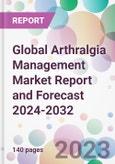The global arthralgia management market size was valued USD 6.5 billion in 2023 driven by the increasing prevalence of joint pain and arthritis, advances in medical technologies, and changing healthcare trends has led to market growth across the globe. The market size is anticipated to grow at a CAGR of 9.1% during the forecast period of 2024-2032 to achieve a value of USD 14.2 billion by 2032.
The arthralgia management market is substantial and continues to grow due to several factors, including an ageing population, rising awareness of joint health, and advancements in treatment options. Joint pain is a common symptom that affects millions of people worldwide, contributing to the market's size and growth. North America and Europe are significant markets for arthralgia management due to their aging populations and well-established healthcare systems. Emerging markets in Asia Pacific, Latin America, and Africa are experiencing growth as healthcare access and awareness improve.
Arthralgia Management: Introduction
Arthralgia, which refers to joint pain, can be a challenging and debilitating condition. It can be caused by various factors, including injury, inflammation, infection, or underlying medical conditions such as arthritis. Effective management of arthralgia is essential to alleviate pain, improve joint function, and enhance the overall quality of life for individuals affected by this condition. Arthralgia management involves a comprehensive approach that aims to alleviate joint pain, improve joint function, and enhance the overall quality of life for individuals affected by this condition. Personalized treatment plans, pain relief strategies, inflammation control, and regular monitoring are crucial elements in helping individuals effectively manage arthralgia and its underlying causes.Key Trends in the Global Arthralgia Management Market
- Increasing Prevalence of Arthralgia and Arthritis: The global aging population and changing lifestyles have contributed to a rise in arthralgia and arthritis cases. As a result, the demand for arthralgia management solutions, including medications and therapies, is growing.
- Shift Towards Non-Pharmacological Approaches: There is a growing emphasis on non-pharmacological approaches to arthralgia management. These include physical therapy, exercise, weight management, and lifestyle modifications. Patients and healthcare providers are recognizing the importance of holistic and non-drug treatments.
- Advancements in Drug Therapies: Pharmaceutical companies are developing new drugs and therapies for managing arthralgia and arthritis. This includes novel pain relief medications and biologic therapies targeting specific inflammatory pathways. Personalized medicine approaches are also being explored.
- Telemedicine and Remote Monitoring: The COVID-19 pandemic accelerated the adoption of telemedicine and remote monitoring in healthcare. Arthralgia patients are increasingly accessing virtual consultations, monitoring their symptoms remotely, and receiving guidance on self-management.
Global Arthralgia Management Market Segmentation
The market can be categorised drug class, treatment, distribution channel, end user and region.Market Breakup by Drug Class
- Drug
- NSAIDs
- Corticosteroids
- Hyaluronic Acid Injection
- Other Drugs
Market Breakup by Treatment
- Knee and Ankle Pain
- Hip Pain
- Shoulder and Elbow Pain
- Others
Market Breakup Disease by Distribution Channel
- Hospital Pharmacies
- Retail Pharmacies
- Online Pharmacies
Market Breakup by Region
- North America
- Europe
- Asia Pacific
- Latin America
- Middle East and Africa
Global Arthralgia Management Market Overview
The market for arthralgia management encompasses a wide range of strategies, treatments, and interventions aimed at addressing joint pain (arthralgia), which can result from various underlying causes, including arthritis, injury, inflammation, or other medical conditions. The market is driven by the increasing prevalence of joint pain and arthritis, advances in medical technologies, and changing healthcare trends.The arthralgia management market is substantial and continues to grow due to several factors, including an ageing population, rising awareness of joint health, and advancements in treatment options. Joint pain is a common symptom that affects millions of people worldwide, contributing to the market's size and growth. North America and Europe are significant markets for arthralgia management due to their aging populations and well-established healthcare systems. Emerging markets in Asia Pacific, Latin America, and Africa are experiencing growth as healthcare access and awareness improve.
Key Players in the Global Arthralgia Management Market
The key features of the market report include patent analysis, grants analysis, clinical trials analysis, funding and investment analysis, partnerships, and collaborations analysis by the leading key players.The major companies in global arthralgia management market are as follows:
- Sanofi
- AstraZeneca
- Johnson & Johnson
- GlaxoSmithKline PLC (UK)
- Bayer AG
- Abbott
- Pfizer, Inc.
- Mylan N.V
- Teva Pharmaceuticals
- Novartis AG
Table of Contents
1 Preface
3 Arthralgia Overview
4 Patient Profile
5 Arthralgia Epidemiology Analysis
6 Global Arthralgia Management Market Overview
7 Global Arthralgia Management Market Landscape
8 Global Arthralgia Management Market Dynamics
9 Global Arthralgia Management Market Segmentation
10 North America Arthralgia Management Market
11 Europe Arthralgia Management Market
12 Asia Pacific Arthralgia Management Market
13 Latin America Arthralgia Management Market
14 Middle East and Africa Arthralgia Management Market
15 Regulatory Framework
16 Patent Analysis
17 Grants Analysis
18 Clinical Trials Analysis
19 Funding and Investment Analysis
20 Partnership and Collaborations Analysis
21 Supplier Landscape
23 Company Competitiveness Analysis (Additional Insight)
24 Payment Methods (Additional Insight)
Companies Mentioned
- Sanofi
- AstraZeneca
- Johnson & Johnson
- GlaxoSmithKline PLC (UK)
- Bayer AG
- Abbott
- Pfizer Inc.
- Mylan N.V
- Teva Pharmaceuticals
- Novartis AG
Methodology

LOADING...








